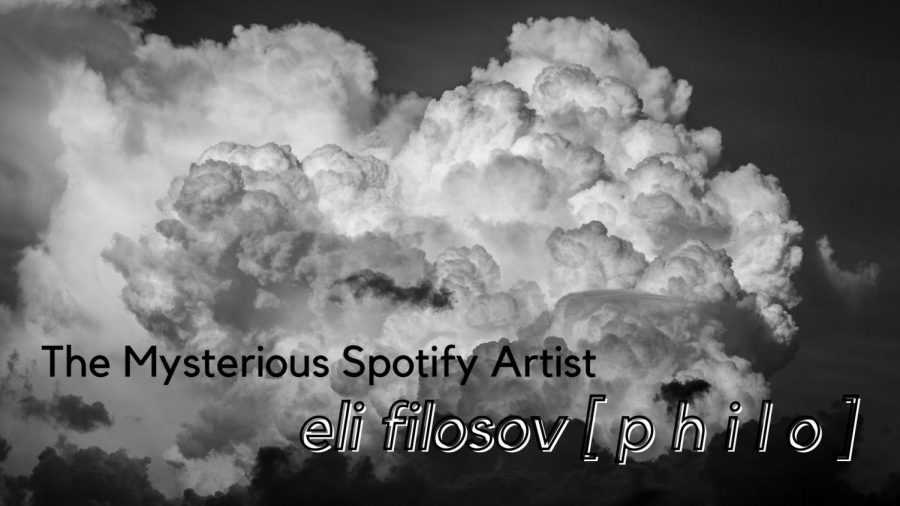The Mysterious Spotify Artist Eli Filosov
Musical artist Eli Filosov is a multi-platform lo-fi instrumentalist that has increased in popularity over the past year. His main success is his song oneofone_rwk, which got popular online across several social media platforms.
September 22, 2021
Eli Filosov is a verified Spotify artist with over 250,000 monthly listeners. He has amassed over 18,500 followers on SoundCloud. He also posts his music on Amazon Music, Apple Music, Tidal, Pandora, iHeartRadio, Deezer, and even has a subreddit on Reddit. His YouTube Topic has over 1.86K subscribers, and its most popular video has over 1.8 million views. His songs have also made an appearance on TikTok and similar short video streaming platforms.
If you’re wondering why you’ve never heard of him, it’s because he’s mostly known for one specific song: oneofone_rwrk, with a whopping 30 million streams on Spotify. The song has another 3.8 million on SoundCloud, and on YouTube, it has 1.3 million. This song has blown up across several platforms, making him spike in popularity. Though he has yet to make mainstream success, his numbers are only growing.
On Spotify, his name is “eli filosov [ p h i l o ],” which is in a style not widely seen across the platform. I believe that he took his own, real name, Eli Filosov, and wrote the nickname “Philo” after the beginning of his last name. This is rather unusual. Why the spaces and brackets? Why put the nickname after his real name?
The answer to that question is style. He chose to write his name like that not only to stand out, but also to identify himself and his music as unique. It’s like a catchphrase, or a signature sound. It all comes down to individualism.
Filosov’s songs also echo this distinctive style. He uses all lowercase letters, numbers, spaces, and no spaces to make a statement. He titles his songs things like artifacts_stbb375 and inthisworld, which are his next two most popular songs. Another example is an album he came out with in 2019 named empty.road, with the very last song of which is titled uh_0h. This peculiar method of titling, using numbers and spaced-out words, must have some sort of purpose. The only thing it could be is stylistic choice, meant to emphasize the uniqueness of the music.
How does his music sound? It’s as distinctive as his name, with the incorporation of several different sources into one. He quotes popular movies, TV, and radio shows from as early as the 1970s. For example, in his song titled blankforest, Filsov uses a quote from the famous philosopher Gerald Heard.
You can actually hear his voice, as the clip is from a recorded interview, “But that’s only the beginning. Suddenly you notice that there aren’t these separations. That we’re not on a separate island shouting across to somebody else and trying to hear, obviously, you’re misunderstanding. You know.”
Another example of quotation is when Filosov uses the words of Artifacts, a hip-hop rap group that started producing music in 1993. The song is called Art of Facts, from the group’s album That’s Them, which was released in 1997. Filosov directly quotes them in his song artifacts_stbb375, his second most popular song on Spotify. He uses verses one and two, layering jazz music on top of the song in order to make it more appealing. It’s quite the fascinating blend of genres.
But not all of his songs contain full sentences or even any words at all. In Filosov’s song anymore, we only hear single words like “Yeah” and fractions of speech in the beginning. Another song titled brink is a simple instrumental, with the only word being his signature “Philo” being spoken halfway through the song.
Throughout all of his albums, songs, and single covers, we only see one appearance of his face. The sole appearance of Filosov’s face that any of his fans will ever see is his profile picture on Spotify. I found this intriguing, since most artists prefer to have their face displayed over everything so the public can worship them. The idea is to be recognized by their fans, and to have how they look be associated with their wealth and fame. But for Filosov, that doesn’t seem to be his main goal.
In fact, just hearing a short clip from any of his songs can give you an idea of who he is as a creator. The only consistency between tracks is his trademark sound, the nickname “Philo” being said by a female voice. Otherwise, the rest of the music is usually a collection of jazz, electronica beats, quotes, pieces of words, record scratches, several beats of silence, static fuzz, and audio fading in and out of hearing. These auditory references seem to come from a time when records were more popular, or when aural media wasn’t as clean-cut as it is today. He calls back to a time when the entertainment industry wasn’t as perfected.
He wants to be seen as someone who appreciates the past, as seen by his inclusion of various quotes from the media of the 1970-1990 era. He wants to make old songs relevant again by reusing the ghosts of old media and making something new. His desire is to create a memory of something we’ve never heard before, a record of the old film and music industry. He isn’t seeking attention, only appreciation for music’s long and vast history.
Another notable characteristic of Filosov’s work is the black and white theme of his album and single covers. Even the sole photo of his face is in black in white, being the profile picture of his Spotify account. I believe that this is yet another reference to another time, one where black and white photos were the most commonly used form of photography. According to the Science and Media Museum of the United Kingdom, properly colored photography didn’t become widely successful until 1907, with the invention of the autochrome. It may be less about the time period itself, or when or where colored photography was available, but more about the emotions that black and white photography had. It’s meant to create a sense of older things, a nod to the media’s history and to give the listener a sense of time.
Eli Filosov’s music is one of the most unique sounds I’ve ever found. The unique style, the nods to past decades, and the record-player style of music creates a chill, lo-fi experience unlike any other I’ve seen. If you’re curious, have a listen. You might find something you weren’t expecting.



